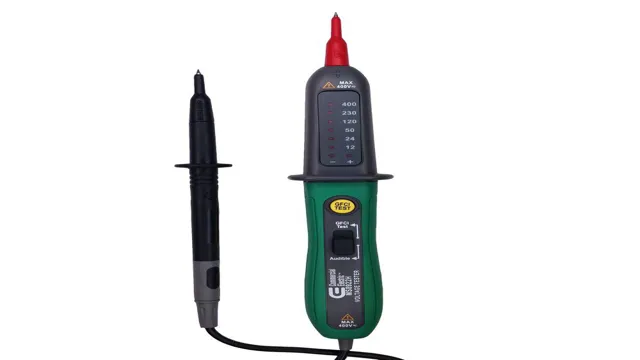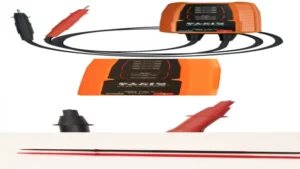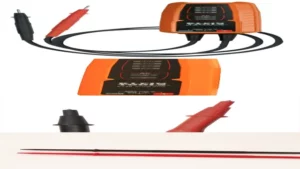Have you ever felt overwhelmed when it comes to using an electric voltage tester? Fear not! Even as a beginner, it’s essential to know how to use an electric voltage tester safely without putting yourself or others at risk. This tool is widely used in the electrical industry and is necessary for detecting circuits’ presence and determining their voltage levels. It’s easy to use, inexpensive, and delivers reliable results, but remember, safety always comes before anything else.
Working with electricity may be challenging, and even experienced electricians and DIYers can make blunders. Electricity, if not handled correctly, can be life-threatening and cause severe injuries. The safety of yourself and others will depend on how well you adhere to safety procedures.
Learning how to use an electric voltage tester safely is a crucial step in ensuring safety during electrical work. In this blog post, we’ll go over the basic steps you need to follow to use an electric voltage tester safely. We will discuss topics such as the importance of checking the voltage tester’s expiration date, verifying the tester’s accuracy, precautionary measures, and more.
By the end of this post, you’ll have the knowledge to use an electric voltage tester safely and effectively, without risking your safety or others around you. So, let’s get started, and learn how to use an electric voltage tester safely!
What is an Electric Voltage Tester?
An electric voltage tester is an essential tool for anyone working on electrical systems. It is a device used to determine the presence or absence of an electric voltage in a circuit. The tool is relatively easy to use and essential in guaranteeing your safety when working with electric systems.
There are different types of voltage testers available, from simple pen-shaped testers to more sophisticated digital meters. To use electric voltage testers, you need to follow some basic steps. First, make sure to select the appropriate voltage tester for the task at hand.
Next, ensure that the voltage tester you select is calibrated correctly. Finally, connect the voltage tester to the circuit and observe the readings on the device. By following these necessary steps, you can quickly and easily determine the presence or absence of electric voltage in a circuit and avoid potential hazards.
Definition and usage
An electric voltage tester is a tool that electricians use to determine the presence and level of electric voltage in a wire, outlet, or appliance. It’s essential to have a voltage tester when working with electrical circuits to prevent electric shocks, electrocution, and damage to your equipment. The tester works by detecting the voltage level in a conductor, often through visual or audible indicators that vary in intensity depending on the voltage detected.
The most basic voltage testers use a neon light that lights up when the conductor’s voltage reaches a particular threshold. Advanced testers use digital displays and can measure different voltage ranges accurately. In summary, an electric voltage tester is a fundamental tool for electricians and homeowners because it detects the presence of voltage and protects the safety of people and equipment.

Different Types of Voltage Testers
When it comes to dealing with electrical systems and appliances, it’s important to have an electric voltage tester at hand. A voltage tester is a tool that measures the electrical potential difference between two points in a circuit, indicating the presence or absence of an electrical current. There are different types of voltage testers, each with their own specific uses.
Non-contact voltage testers are the most common type and are used to check the presence of voltage without making any direct contact with the wires. Contact voltage testers, on the other hand, require direct contact with the wires in order to measure the voltage. Digital voltage testers are another popular option and provide an accurate numerical reading of the voltage level.
When using an electric voltage tester, it’s important to follow safety procedures and wear protective equipment such as gloves and safety glasses.
Non-contact and contact voltage testers
Voltage testers are essential tools for electricians and DIY enthusiasts. These testers can help you determine whether a wire or electrical component is live or not. There are different types of voltage testers available in the market.
One of the most popular types of voltage testers is the non-contact voltage tester. It is a safe and straightforward tool that can detect electrical fields without coming into contact with the wire or component. Another type of voltage testers is the contact tester, which requires direct contact with the electrical component.
This type of tester can provide more accurate results and can be used for testing continuity. Both types of testers have their own advantages and disadvantages, and it’s essential to choose the right one for the job. Overall, voltage testers are crucial tools for electrical safety, and it’s essential to use them properly and with caution to avoid any accidents.
Voltage testers with multimeters
If you’re looking for a voltage tester, there are different types available for your needs. One of the most popular types is the voltage tester with a multimeter. This type of tester is ideal for measuring voltage, resistance, and current.
It is an essential tool for electricians, technicians, and hobbyists who deal with electrical components and circuits. It simplifies the measurement process and provides accurate readings that help in determining the cause of any electrical issue. A great thing about this type of tester is that it offers both analog and digital displays.
The digital display gives precise readings, while the analog display gives a more straightforward representation of the amount of voltage or current being measured. So, choose the voltage tester with a multimeter that suits your needs and adds it to your toolkit to tackle all your electrical problems with confidence.
Preparing for Usage
If you’re planning on using an electric voltage tester, it’s important to prepare yourself and the tool properly beforehand. The first step is to ensure that the device is functional and fully charged. Make sure to inspect the cord and the probe for any damages before using it.
Once you’re confident that the tester is in working order, it’s essential to identify the power source and turn off the electricity before testing. This will prevent accidents and ensure your safety. When testing, use the tester by holding it by the insulated handle and placing the tip on the wire or outlet you’re testing.
The tester should light up or beep if there’s electricity running through it. If it doesn’t, double-check that it’s correctly connected to the power source and try again. Remember never to touch any wires or electrical outlets without turning off the power first.
With these precautions and tips in mind, using an electric voltage tester can be straightforward and safe.
Know the voltage range of the tester
When it comes to using an electrical tester, it’s essential to know the voltage range of the device before you start testing. This information is usually displayed on the tester itself or in the manual that comes with it. The voltage range indicates the maximum voltage that the tester can detect, and it is crucial to know this range to ensure your safety while performing any electrical work.
If you use a tester that cannot handle the voltage, it could result in electrical shock or damage to the tester. Therefore, make sure to check the voltage range of the tester before use to avoid any mishaps. Remember, safety should always come first when working with electrical equipment.
Ensure your tester is in good condition
One important aspect of using a tester is ensuring that it is in good condition before usage. This means checking for any cracks, leaks, or other damages that could affect its accuracy or safety. It’s also essential to make sure that the tester is calibrated correctly and that its batteries are fully charged.
Before testing anything, always refer to the user manual and follow the recommended procedures for setup and usage. It’s also a good idea to periodically clean and maintain the tester to ensure that it continues to function properly. By properly preparing and maintaining your tester, you can have confidence in the results it provides and ensure that it remains a reliable tool for years to come.
Remember, a properly maintained tester is necessary for detecting errors and preventing potential hazards.
Ensure tester is compatible with the environment
Before using a tester, it’s essential to ensure its compatibility with the environment where it will be used. Different testing tools have different requirements, and failing to verify compatibility can lead to inaccurate results and wasted resources. Therefore, before starting any testing process, take the time to analyze the environment and check the software or hardware requirements for the chosen testing tool.
This preparation step will ensure that the tester can function correctly in the given environment and avoid any potential hiccups. So, always remember to “measure twice, cut once” when it comes to test compatibility.
Using an Electric Voltage Tester
If you are planning on doing some electrical work around your house, it is essential to know how to use an electric voltage tester. This tool is designed to detect the presence of an electrical current in a wire or device, making it a valuable tool for any DIY electrician. To use it, first, make sure the device is turned off, and gloves are worn to prevent electric shock.
Next, hold the tester near the wire or device and press the button. If the tester lights up, there is an electrical current present, and it is unsafe to work on the device. On the other hand, if the tester doesn’t light up, the device is safe, and you can continue working on it.
Check all wires and devices before proceeding with any electrical work. Remember, safety should always be your top priority when working with electricity. So, knowing how to use an electric voltage tester is an important step for any DIY electrician preparing to work on their electrical system, and always handle electricity with care.
Switch off power to the circuit
When working on any electrical project, one of the essential safety protocols to follow is to switch off power to the circuit. However, before you do that, you need to ensure there is no electricity flowing through the wires. That’s where an electric voltage tester comes in.
Using a voltage tester is simple and straightforward. First, turn the circuit on and then hold the voltage tester to the wire or outlet you want to test. If the tester beeps or lights up, that means there is electricity flowing through the wire, and you need to switch off the power before proceeding.
It’s crucial to use an electric voltage tester before working on any electrical project to avoid electrocution or starting a fire. Remember, safety should always come first.
Select the appropriate voltage range and setting
When using an electric voltage tester, one of the most critical steps is selecting the appropriate voltage range and setting. You should always pick a range that covers the voltage you expect to measure, but not one that is too high or low. If you’re not sure what voltage range to use, start with the highest setting and work your way down until you get a reading.
Keep in mind that electric voltage testers come in different types, including non-contact testers, contact testers, and clamp meters. Each type has its own voltage range and sensitivity, so it’s essential to choose the right one for your needs. Additionally, always make sure that the tester you’re using is calibrated correctly to ensure accurate readings.
Running a quick calibration check before use can help avoid any potential inaccuracies that could cause harm. Remember, taking the time to select the right voltage range and setting for your electric voltage tester can help prevent electrical accidents and keep you safe while working with electricity.
Touch the contact points with the tester
If you’re looking to use an electric voltage tester, it’s essential to know how to do it safely and effectively. One critical step is to touch the contact points with the tester. This ensures that you get a proper reading of the voltage.
The contact points are the two metal tips on the end of the tester. You should make sure that these touch the area you want to test, whether it’s a wire, an outlet, or some other electrical component. It’s vital to keep in mind that electricity is dangerous, and you should take the necessary precautions.
Before using the tester, make sure that you’re wearing the appropriate safety gear, such as rubber gloves and safety glasses. And if you’re unsure about what you’re doing, it’s always best to call a professional electrician to help you out. Remember, your safety should always come first when dealing with electricity.
Interpret the results
Interpreting electrical voltage tester results can be tricky for those who are not familiar with how to use it. However, with a little bit of practice, it can become quite simple. To begin, ensure that the tester is properly calibrated by checking the instructions.
Then, make sure that the tester is in contact with the electrical circuit to obtain an accurate reading. When the power source is turned on, the voltage reading should appear on the tester. If the reading is within the recommended range, the circuit is working properly.
On the other hand, if the reading is outside the recommended range, there may be an issue with the circuit such as an overload or a short. Understanding how to use an electric voltage tester can help identify potential issues and ensure that electrical circuits are working correctly. So, if you’re having issues with your circuits, give an electrical voltage tester a try to help determine the cause of the problem.
Conclusion
In conclusion, using an electric voltage tester is a shocking experience. But fear not, with a little practice and caution, you too can master the art of testing voltage like a pro. Remember, always read the instructions carefully, wear protective gear, and avoid testing on live wires.
So, don’t be shocked, be electrified and test on, my friends!”
FAQs
What is an electric voltage tester used for?
An electric voltage tester is used to check the presence and strength of electrical voltage in a circuit or outlet.
How do you use an electric voltage tester?
To use an electric voltage tester, you need to first ensure that the tester is properly calibrated and that you are using the correct setting for the voltage you are testing. Then, you can hold the tester against the circuit or outlet to check for the presence and strength of electrical voltage.
Is it safe to use an electric voltage tester?
Yes, it is safe to use an electric voltage tester as long as you follow proper safety precautions, such as wearing rubber gloves and using a tester with insulated leads.
How do you know if an outlet is live or not?
You can use an electric voltage tester to check if an outlet is live or not by holding the tester against the outlet’s terminals. If there is electrical voltage present, the tester will light up or beep.
What is the difference between an analog and digital voltage tester?
An analog voltage tester displays voltage readings using a needle and a scale, while a digital voltage tester displays voltage readings on a digital screen. Digital testers usually offer more precise and accurate readings.
Can you use an electric voltage tester on a live wire?
Yes, you can use an electric voltage tester on a live wire as long as you follow proper safety precautions and use a tester with insulated leads.
What should you do if an electric voltage tester indicates the presence of electrical voltage?
If an electric voltage tester indicates the presence of electrical voltage, do not touch the circuit or outlet. Instead, turn off the power source and contact a licensed electrician to inspect and repair the issue.






